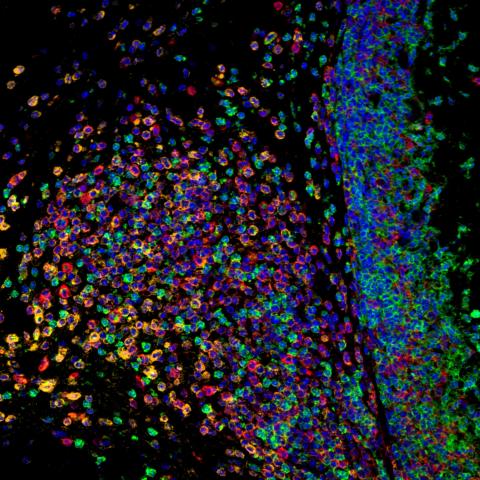
Microscopy image of the immune response to a scaffold-assisted cancer vaccine injected in mice. Neutrophils (green), macrophages (yellow) and antigen-presenting cells (red) are among the immune cells attracted to the scaffold-assisted vaccine. (Cell nuclei, blue) Image credit: Wolf et al.
Researchers have developed a biomaterial that, when combined with a cancer vaccine, substantially boosts the efficacy of the vaccine. In a study published February 1, 2024, in Advanced Materials, the approach was able to eliminate tumors in more than half of the mice studied.
Cancer vaccines are useful therapies that “train” the immune system to better attack cancer, but these therapies only work in some patients. Matthew T. Wolf, Ph.D., a Stadtman Investigator in the Cancer Innovation Laboratory, was interested in exploring biomaterials as a way to make cancer vaccines more effective.
Wolf’s team developed a biomaterial that acts as scaffolding, which both recruits immune cells and traps a cancer vaccine within it, allowing the vaccine to linger near the site longer rather than dissipating throughout the patient’s body. “That means you can give a larger dose and know it won’t immediately escape and possibly cause toxic effects,” explains Wolf.
In their study, Wolf’s team also added a compound to the biomaterial that activates cancer-fighting immune cells known as cytotoxic T lymphocytes. While the scaffolding stimulates an immune response, the cancer vaccine helps those immune cells learn to target the tumor on site more effectively, creating a dual anti-cancer effect.
While some scientists have previously created biomaterials that attract the immune cells associated with infection, Wolf and his colleagues designed theirs so that it also attracts immune cells that are important to wound healing in a post-surgery setting.
The researchers tested their therapy in mice with lymphoma tumors. The scaffolding on its own stimulated the immune systems of the mice and, when combined with a cancer vaccine designed to target lymphoma, was able to cure 50 to 75% of their tumors. Many days after the tumors disappeared, the mice were rechallenged with more tumors, and their immune systems successfully attacked and eradicated those as well.
“Using this biomaterial that promotes wound healing and regeneration results in a long-lasting, high-quality immunity, which was completely new and interesting for us,” says Wolf.
He envisions this anti-cancer treatment being used after a patient has undergone surgery to remove their tumors, where it could be added near the surgery site to treat residual cancer. “That is where I hope we can make an impact,” he says.